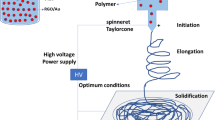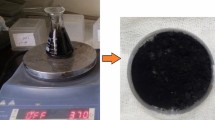Abstract
In the field of nerve tissue engineering, nanofibrous scaffolds could be a promising candidate when they are incorporated with electrical cues. Unique physico-chemical properties of gold nanoparticles (AuNPs) make them an appropriate component for increasing the conductivity of scaffolds to enhance the electrical signal transfer between neural cells. The aim of this study was fabrication of AuNPs-doped nanofibrous scaffolds for peripheral nerve tissue engineering. Polycaprolactone (PCL)/chitosan mixtures with different concentrations of chitosan (0.5, 1 and 1.5) were electrospun to obtain nanofibrous scaffolds. AuNPs were synthesized by the reduction of HAuCl4 using chitosan as a reducing/stabilizing agent. A uniform distribution of AuNPs with spherical shape was achieved throughout the PCL/chitosan matrix. The UV–Vis spectrum revealed that the amount of gold ions absorbed by nanofibrous scaffolds is in direct relationship with their chitosan content. Evaluation of electrical property showed that inclusion of AuNPs significantly enhanced the conductivity of scaffolds. Finally, after 5 days of culture, biological response of Schwann cells on the AuNPs-doped scaffolds was superior to that on as-prepared scaffolds in terms of improved cell attachment and higher proliferation. It can be concluded that the prepared AuNPs-doped scaffolds can be used to promote peripheral nerve regeneration.






Similar content being viewed by others

References
Xie J, MacEwan MR, Liu W, Jesuraj N, Li X, Hunter D, et al. Nerve guidance conduits based on double-layered scaffolds of electrospun nanofibers for repairing the peripheral nervous system. ACS Appl Mater Interfaces. 2014;6:9472–80.
Evans GR. Challenges to nerve regeneration. Semin Surg Oncol. 2000;19:312–318.
Verreck G, Chun I, Li Y, Kataria R, Zhang Q, Rosenblatt J, et al. Preparation and physicochemical characterization of biodegradable nerve guides containing the nerve growth agent sabeluzole. Biomaterials. 2005;26:1307–15.
Bhatheja K, Field J. Schwann cells: origins and role in axonal maintenance and regeneration. Int J Biochem Cell Biol. 2006;38:1995–9.
Gordon T, Udina E, Verge VM, de Chaves EI. Brief electrical stimulation accelerates axon regeneration in the peripheral nervous system and promotes sensory axon regeneration in the central nervous system. Mot Control. 2009;13:412–41.
Ming G, Henley J, Tessier-Lavigne M, Song H, Poo M. Electrical activity modulates growth cone guidance by diffusible factors. Neuron. 2001;29:441–52.
Lovat V, Pantarotto D, Lagostena L, Cacciari B, Grandolfo M, Righi M, et al. Carbon nanotube substrates boost neuronal electrical signaling. Nano Lett. 2005;5:1107–10.
Prabhakaran MP, Ghasemi-Mobarakeh L, Jin G, Ramakrishna S. Electrospun conducting polymer nanofibers and electrical stimulation of nerve stem cells. J Biosci Bioeng. 2011;112:501–7.
Baniasadi H, AR SA, Mashayekhan. S. Fabrication and characterization of conductive chitosan/gelatin-based scaffolds for nerve tissue engineering. Int J Biol Macromol. 2015;74:360–6.
Khosroshahi ME, Hassannejad Z, Firouzi M, Arshi AR. Nanoshell-mediated targeted photothermal therapy of HER2 human breast cancer cells using pulsed and continuous wave lasers: an in vitro study. Lasers Med Sci. 2015;30:1913–22.
Cole LE, Ross RD, Tilley JM, Vargo-Gogola T, Roeder RK. Gold nanoparticles as contrast agents in x-ray imaging and computed tomography. Nanomed. 2015;10:321–41.
Ghosh P, Han G, De M, Kim CK, Rotello VM. Gold nanoparticles in delivery applications. Adv Drug Deliv Rev. 2008;60:1307–15.
McKeon‐Fischer K, Freeman J. Characterization of electrospun poly (L‐lactide) and gold nanoparticle composite scaffolds for skeletal muscle tissue engineering. J Tissue Eng Regen Med. 2011;5:560–8.
Shevach M, Maoz BM, Feiner R, Shapira A, Dvir T. Nanoengineering gold particle composite fibers for cardiac tissue engineering. J Mater Chem B. 2013;1:5210–7.
Heo DN, Ko WK, Bae MS, Lee JB, Lee DW, Byun W, et al. Enhanced bone regeneration with a gold nanoparticle–hydrogel complex. J Mater Chem B. 2014;2:1584–93.
Huang H, Yang X. Synthesis of polysaccharide-stabilized gold and silver nanoparticles: a green method. Carbohydr Res. 2004;339:2627–31.
Esumi K, Hosoya T, Suzuki A, Torigoe K. Spontaneous formation of gold nanoparticles in aqueous solution of sugar-persubstituted poly(amidoamine)dendrimers. Langmuir. 2000;16:2978–80.
Fujiwara K, Ramesh A, Maki T, Hasegawa H, Ueda K. Adsorption of platinum (IV), palladium (II) and gold (III) from aqueous solutions onto l-lysine modified crosslinked chitosan resin. J Hazard Mater. 2007;146:39–50.
Wang B, Chen K, Jiang S, Reincke F, Tong W, Wang D, et al. Chitosan-mediated synthesis of gold nanoparticles on patterned poly(dimethylsiloxane) surfaces. Biomacromolecules. 2006;7:1203–9.
Van der Schueren L, Steyaert I, De Schoenmaker B, De Clerck K. Polycaprolactone/chitosan blend nanofibers electrospun from an acetic acid/formic acid solvent system. Carbohydr Polym. 2012;88:1221–6.
Sangsanoh P, Supaphol P. Stability improvement of electrospun chitosan nanofibrous membranes in neutral or weak basic aqueous solutions. Biomacromolecules. 2006;7:2710–4.
Almodovar J, Kipper MJ. Coating electrospun chitosan nanofibers with polyelectrolyte multilayers using the polysaccharides heparin and N,N,N-trimethyl chitosan. Macromol Biosci. 2011;11:72–6.
Huang Y, Onyeri S, Siewe M, Moshfeghian A, Madihally SV. In vitro characterization of chitosan–gelatin scaffolds for tissue engineering. Biomaterials. 2005;26:7616–27.
Amaral IF, Unger RE, Fuchs S, Mendonca AM, Sousa SR, Barbosa MA, et al. Fibronectin-mediated endothelialisation of chitosan porous matrices. Biomaterials. 2009;30:5465–75.
Francisco Peirano AR, Flores JA. Adsorption of gold ions by chitosan biopolymer. Soc Quim Del Peru. 2003;69:211–21.
Pauw LJvd. A method of measuring the resistivity and Hall coefficient on lamellae of arbitrary shape. Philips Tech Rev. 1958;20:220–4.
Rajabi M, Firouzi M, Hassannejad Z, Haririan I, Zahedi P. Fabrication and characterization of electrospun laminin-functionalized silk fibroin/poly(ethylene oxide) nanofibrous scaffolds for peripheral nerve regeneration. J Biomed Mater Res. 2017. https://doi.org/10.1002/jbm.b.33968.
Nategh M, Firouzi M, Naji-Tehrani M, Oryadi Zanjani L, Hassannejad Z, Nabian MH, et al. Subarachnoid space transplantation of Schwann and/or olfactory ensheathing cells following severe spinal cord injury fails to improve locomotor recovery in rats. Acta Med Iran. 2016;54:562–9.
Hassannejad Z, Khosroshahi ME. Synthesis and evaluation of time dependent optical properties of plasmonic–magnetic nanoparticles. Opt Mater. 2013;35:644–51.
Cheng M, Wang H, Zhang Z, Li N, Fang X, Xu S. Gold nanorod-embedded electrospun fibrous membrane as a photothermal therapy platform. ACS Appl Mater Interfaces. 2014;6:1569–75.
Cohen-Karni T, Jeong KJ, Tsui JH, Reznor G, Mustata M, Wanunu M, et al. Nanocomposite gold-silk nanofibers. Nano Lett. 2012;12:5403–6.
Fang X, Ma H, Xiao S, Shen M, Guo R, Cao X, et al. Facile immobilization of gold nanoparticles into electrospun polyethyleneimine/polyvinyl alcohol nanofibers for catalytic applications. J Mater Chem. 2011;21:4493–501.
Miyama T, Yonezawa Y. Aggregation of photolytic gold nanoparticles at the surface of chitosan films. Langmuir ACS J Surf Colloids. 2004;20:5918–23.
Adlim A, Bakar MA. Preparation of chitosan-gold nanoparticles: part 2. The roles of chitosan. Indo J Chem. 2010;8:320–6.
Yahyaei B, Manafi S, Fahimi B, Arabzadeh S, Pourali P. Production of electrospun polyvinyl alcohol/microbial synthesized silver nanoparticles scaffold for the treatment of fungating wounds. Appl Nanosci. 2018;8:417–426.
Hong Kyung H. Preparation and properties of electrospun poly(vinyl alcohol)/silver fiber web as wound dressings. Polym Eng Sci. 2006;47:43–49.
Wan Y, Creber KAM, Peppley B, Bui VT. Ionic conductivity of chitosan membranes. Polymer. 2003;44:1057–65.
Slupkowski T. Electrical conductivity of polyester polymer containing carbon black. Phys Status Solid A. 1985;90:737–41.
Acknowledgements
This study was supported by Tehran University of Medical Sciences, Tehran, Iran (No. 97-01-84-38323).
Author information
Authors and Affiliations
Corresponding author
Ethics declarations
Conflict of interest
The authors declare that they have no conflict of interest.
Electronic supplementary material
Rights and permissions
About this article
Cite this article
Saderi, N., Rajabi, M., Akbari, B. et al. Fabrication and characterization of gold nanoparticle-doped electrospun PCL/chitosan nanofibrous scaffolds for nerve tissue engineering. J Mater Sci: Mater Med 29, 134 (2018). https://doi.org/10.1007/s10856-018-6144-3
Received:
Accepted:
Published:
DOI: https://doi.org/10.1007/s10856-018-6144-3



